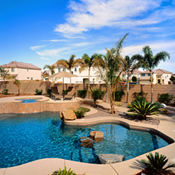
Shotcrete Pools & Spas – Basic Knowledge by 360 Exteriors of Las Vegas, Nevada
Brought to you by the professional pool & spa builders at 360 Exteriors of Las Vegas, Nevada
Concrete durability and strength as well as the technique used during it’s application contribute to the overall structural longevity. Here are some basic shotcrete best practices.
Shooting for Strength, Velocity & Structural Density of a Shotcrete Pool and Spa
Concrete and engineering experts debate the minimum psi from which pool and spa shells ought to be applied. Environmental weather conditions are always a major factor.
The argument over shotcrete strength depends on which kind of mix is to be used. Should engineers specify 4,000 psi, thus needing a higher cement content, or is 2,500 psi adequate for areas without severe weather conditions or terrain issues?
Then again, concrete strength and toughness also rely on the techniques used during it’s application. Here are some shotcrete fundamentals..
Don’t add water to the mix. The perfect shotcrete mix for pools & spas is designed to contain a certain amount of aggregate, cement and water, and adding too much H20 will most definitely weaken the finished product. When additional workability is needed, try to use admixtures instead of water. This will ensure you retain structural integrity throughout your shotcrete mix once it has cured.
Develop the right velocity when shooting. A large part of what makes shotcrete strong is the velocity at which it’s applied at. It compresses and gives the material a perfect density, helps prevent sagging, and will also ensure proper and thorough coverage of the structural rebar.
360 Exteriors professionals say that shotcrete should move at a speed of approximately 400 feet per second. To achieve this, they most certainly recommend compressors that generate air at a minimum of 250 cubic feet per minute. Ratings of 325- to 350 cfm are even more appealing. We advise to go even higher in severe-weather conditions, where the compressors must work harder.
We always practice proper nozzling. The shotcrete needs to hit the substrate with optimal impact. We accomplish this by having our nozlers stand no more than 4 feet back from the intended surface and always hold the nozzle at a 90-degree angle. Shooting from farther away or at a different angle will diminish the impact thus lessening the compaction.
Dispose of the rebound. As the concrete hits the surface area, aggregate will always bounce off the wall and fall to the ground. That’s because these bits aren’t coated with the proper amount of cement to help them bond with the concrete.
Some applicators will conceal the rebound within stairwells or in the pool or spa floor. This practice will almost always compromise the integrity of the shell since rebound doesn’t have the right cement content and hasn’t been applicated at a high enough velocity.
Rebound should be removed by shoveling it into a wheelbarrow and taken off the property or residential premises. Not only is this a ideal practice, but it’s stipulated in the International Building Code.

 360 Exteriors LLC.
360 Exteriors LLC.